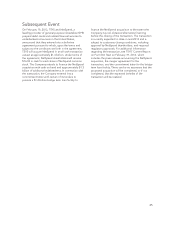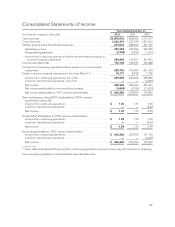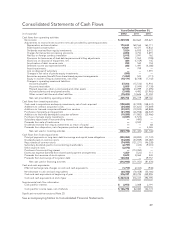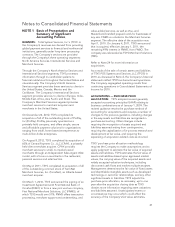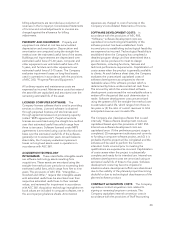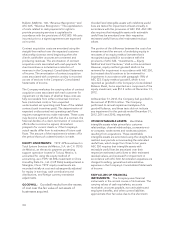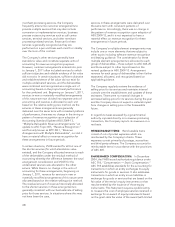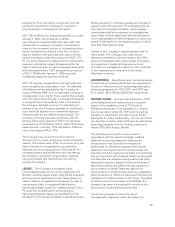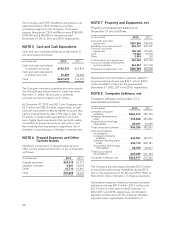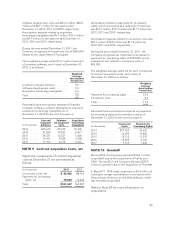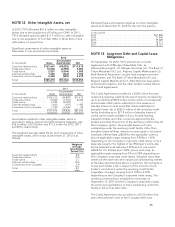NetSpend 2012 Annual Report Download - page 38
Download and view the complete annual report
Please find page 38 of the 2012 NetSpend annual report below. You can navigate through the pages in the report by either clicking on the pages listed below, or by using the keyword search tool below to find specific information within the annual report.maturities of these assets and liabilities. The fair value
of the Company’s long-term debt and obligations
under capital leases is not significantly different from
its carrying value.
Investments in equity investments are accounted for
using the equity method of accounting and pertain to
privately held companies for which fair value is not
readily available. The Company believes the fair
values of its investments in equity investments
exceed their respective carrying values.
IMPAIRMENT OF LONG-LIVED ASSETS: In
accordance with ASC 360, the Company reviews
long-lived assets, such as property and equipment
and intangibles subject to amortization, including
contract acquisition costs and certain computer
software, for impairment whenever events or changes
in circumstances indicate that the carrying amount of
an asset may not be recoverable. Recoverability of
assets to be held and used is measured by a
comparison of the carrying amount of an asset to
estimated undiscounted future cash flows expected
to be generated by the asset. If upon a triggering
event the Company determines that the carrying
amount of an asset exceeds its estimated
undiscounted future cash flows, an impairment
charge is recognized by the amount by which the
carrying amount of the asset exceeds the fair value of
the asset. Assets to be disposed of would be
separately presented in the balance sheet and
reported at the lower of the carrying amount or fair
value less costs to sell, and would no longer be
depreciated. The assets and liabilities of a disposed
group classified as held for sale would be presented
separately in the appropriate asset and liability
sections of the balance sheet.
TRANSACTION PROCESSING PROVISIONS: The
Company has recorded an accrual for contract
contingencies (performance penalties) and
processing errors. A significant number of the
Company’s contracts with large clients contain
service level agreements which can result in TSYS
incurring performance penalties if contractually
required service levels are not met. When providing
for these accruals, the Company takes into
consideration such factors as the prior history of
performance penalties and processing errors
incurred, actual contractual penalties inherent in the
Company’s contracts, progress towards milestones
and known processing errors not covered by
insurance.
These accruals are included in other current liabilities
in the accompanying Consolidated Balance Sheets.
Increases and decreases in transaction processing
provisions are charged to cost of services in the
Company’s Consolidated Statements of Income, and
payments or credits for performance penalties and
processing errors are charged against the accrual.
REDEEMABLE NONCONTROLLING
INTEREST: In connection with the acquisition of
CPAY, the Company is party to call and put
arrangements with respect to the membership units
that represent the remaining noncontrolling interest
of CPAY. The call arrangement is exercisable by TSYS
and the put arrangement is exercisable by the Seller.
The put arrangement is outside the control of the
Company by requiring the Company to purchase the
Seller’s entire equity interest in CPAY at a put price at
fair market value. The put arrangement is recorded
on the balance sheet and is classified as redeemable
noncontrolling interest outside of permanent equity.
The call and put arrangements for CPAY,
representing 40% of its total outstanding equity
interests, may be exercised at the discretion of TSYS
or the Seller on the second anniversary of the closing
and upon the occurrence of certain other specified
events.
The put option is not currently redeemable, but a
redemption is considered probable based upon the
passage of time of the second anniversary date. As
such, the Company has adopted the accounting
policy to accrete changes in the redemption value
over the period from the date of issuance to the
earliest redemption date, which the Company
believes to be two years. If the put option was
currently redeemable, the redemption value at
December 31, 2012 is estimated to be approximately
$39.5 million. The Company did not accrete any
changes to the redemption value as the balance at
December 31, 2012 exceeded the accretion fair value
amount.
NONCONTROLLING INTEREST: In December
2007, the Financial Accounting Standards Board
(FASB) issued authoritative guidance under ASC 810,
“Consolidation.” ASC 810 changes the accounting
for noncontrolling (minority) interests in consolidated
financial statements, including the requirements to
classify noncontrolling interests as a component of
consolidated shareholders’ equity, the elimination of
“minority interest” accounting in results of operations
and changes in the accounting for both increases and
decreases in a parent’s controlling ownership
interest.
35


